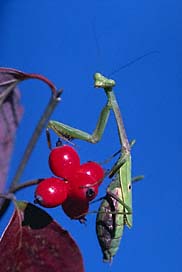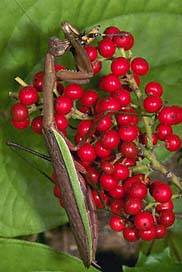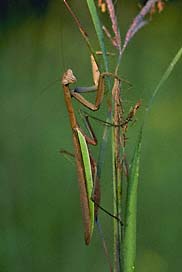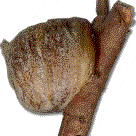 |
 |
 |
| Stagmomantis carolina | Tenodera aridifolia | Mantis religiosa |
Raising Praying Mantis from egg can be a fun an educational way to learn about this ferocious predator. It is the only insect that can swivel its triangular head around to look over its shoulder, if it can be said to have a shoulder. The female makes use of this flexibility during mating: when the smaller male jumps on her back to copulate, she simply turns her head and bites off his head. This does not occur in all species; many smaller species such as Ameles spallanzania are not cannibalistic at all. But in some species it is obligatory and the male can not pass on the spermatophore containing his sperm until he has lost his head. The copulatory activity of the male is under the control of his last abdominal ganglion, so his performance is not affected by the removal of his head; in cases where the sub-oesophageal ganglion of the head secretes inhibitory substances, removing the head may actually improve the mating process. In Tenodera aridifolia, the female rewards the male's sacrifice by being "faithful" to him; she only mates once. ( http://www.earthlife.net/insects/mantodea.html)
Mantids will devour anything they can capture, including snakes, mice, and hummingbirds. After eating, they clean their face like a cat. They capture their prey by stealth: their color and shape allow them to blend into the background, and they wait with their femurs raised in "praying" position. When prey strays within about 4 inches of their reach, they can strike in 5 hundredths of a second, faster than the eye can see. They are also capable of holding prey in one claw and strike again with the other. Their stealthy movement has inspired several martial arts disciplnes.
You may think they may reduce the pest insect population in your garden or yard, but since they do not discriminate between "pest" and "beneficial" insects, and can easily wander off your property, they should not be considered "biological control" agents. But if you have a heavy infestation of Japanese Beetles, it may not hurt to release a few manitds in their neighborhood.
 |
 |
 |
| Stagmomantis carolina | Tenodera aridifolia | Mantis religiosa |
The mantid native to North America is Carolina Mantis, Stagmomantis carolina,
a southern species whose range extends to southern Illinois; it gorws to about 2 inches long.
The most common mantid I have found in northern Illinois is Chinese Mantis,
Tenodera aridifolia, which was deliberately introduced from Asia in 1896
around Philadelphia as a "beneficial" insect. It is much larger than
Stagmomantis carolina, growing to 5 inches long, with green along the front of its
forewings.
Another alien is the European Mantis, Mantis religiosa, somewhat smaller than
Stagmomantis carolina; it is found mostly in the Eastern states. It was introduced
accidentally in 1899 in nursery stock into northwestern New York. The descriptions below
apply to Tenodera aridifolia commonly found in northern Illinois.

Females lay eggs in an egg case called an ootheca; a liquid secreted from the ovipositor is mixed with air to make a froth that solidifies into a case as hard as a walnut shell around the eggs. The eggs cases are deposited in fall and the eggs overwinter in the hardened foam, which provides insulation and protection from ants. The foam also contains a bird and mouse repellent that gives it a pungent smell, but that does not protect the eggs from parasitic wasps which can use long thin ovipositors to lay eggs in the eggs. The egg cases are usually wrapped around stems of shrubs or grasses; they are oblong masses about 1 inch long, with one end more angular than the other, yellow-brown in color. If you find some and want to harvest them, try not to break twigs on desirable plants. I have found them on buckthorn and dead grass stalks that I don't mind breaking. Leave them in a cool area protected from predators and precipitation; I put them in a jar with some holes in the lid, in a shady spot outside, weighted so it doesn't blow around in the wind.
They should hatch in June. A single egg case can contain several hundred eggs; if you keep the hatchlings in a confined space, they may wind up eating each other. Whether you release any of the introduced Tenodera aridifolia is a small ecological problem you need to ponder. For information on raising mantids: